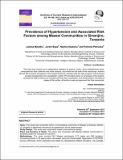| dc.description.abstract | Aims: This study was conducted within a rural pastoral community of Maasai in Simanjiro District
of Tanzania to determine prevalence of hypertension and its determinants.
Study Design: This study was a population based cross-sectional design.
Place and Duration of Study: This study was conducted with Maasai pastoral communities in
Simanjiro District of Tanzania in mid-2015.
Methodology: The study included 561 Maasai participants (175 males and 386 females).
Consenting adults (≥ 25 years) were interviewed using the World Health Organization STEPWISE
survey instrument, which examined and tested for hypertension related indicators. The average age (years) of the participants was 39±13.9. Most of the respondents (46.9%) were in the age
group of 25-34 years.
Results: The prevalence for hypertension within this sub-population was 21.3%, 95% CI [18,25].
Systolic blood pressure was significantly (p<0.05) associated with diastolic blood pressure, heart
rate, weight, height, body mass index, waist circumference, abdominal obesity, history of raised
blood glucose, fruit servings per day, main work, and vigorous work done. The majority (96.26%) of
Maasai participants were physically active, with those in the 24-34 year age group having higher
metabolic equivalents (10563.92±7552) than the 65+ group (4852.09±5835.272) (p< 0.0001).
Hypertensive participants showed lower metabolic equivalents (179.2±107.7) than their nonhypertensive
counterparts (297.6±53.1). The majority of participants were within normal weights for
both men (57.1%) and women (63.2%), but body mass index differed according to age groupings
(p = 0.0454) and hypertensive status (p=0.0063). A small proportion (0.7%) of participants had a
history of raised blood glucose; however, hypertensive participants had significantly (p=0.0136)
higher blood glucose levels. Fruits and vegetable intake was similar among hypertensive and nonhypertensive
participants; however, there was a significant difference across age groups
(p=0.0085). The awareness rate amongst participants of hypertension was low at 17.5%.
Conclusion: Given this key finding that hypertension prevalence among the rural Maasai
community was found to be high and awareness rate was low, it is imperative to put strategies in
place for primary prevention and targeted treatment of hypertension directed at this sub-population. | en_US |

